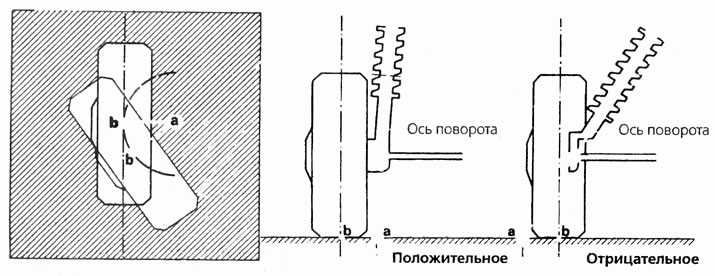Toe-in: When driving in a straight line, the wheels in front are slightly closer than in the rear. They roll towards each other to a certain extent. They say rut «positive» or at the car «wheel alignment». Wheels that are exactly parallel to each other tend to move apart. The friction between the wheel and the road pushes the left wheel to the left and the right wheel to the right. This leads to tire abrasion and wheel wobble. Due to the convergence, the wheels themselves roll in parallel, without the desire to go sideways. When turning, the positive toe-in turns into «negative convergence» due to the trapezoidal arrangement of the steering rods. The inner wheel rotates more than the outer wheel relative to the turn. This is also necessary, because the inner wheels in relation to the turn should describe a smaller circle than the outer ones. This automatically maintains rudder movement and steering force.

If (imaginary) the continuation of the axis of rotation meets the road surface outside the middle of the wheel, then the running-in shoulder is negative. If this continuation meets the road inside from the middle of the wheel, then the run-in shoulder is positive. Under the axis of rotation is understood the line around which the wheel turns when steering.

In order for you to better understand the concepts on this page, we have visually demonstrated them in the form of a picture.
Camber: this is the name given to the slight tilt of the front wheels towards the outside - at the top in the wheel arch in the Vectra, the distance between them is less than below on the ground. In the language of professionals, this is called «negative» collapse. The wheel rests to a certain extent on the outside of the turn.
Lateral lean: it has to do with camber. Lateral tilt is a slight tilt of the axis of rotation in order to turn the entire mechanism when driving. Between the two axes of rotation, the distance at the top is less than at the bottom. Camber and lateral tilt additionally prevent wheel runout. In addition, they make them easy to turn.
Longitudinal inclination: this is understood as the inclined position of the rotary axis in the longitudinal direction of the car, while the wheels, so to speak, are pulled together. This helps to stabilize the straight line and prevent front wheel wobble. In addition, it contributes to the return of the steering wheel to its original position after a turn.

Visitor comments